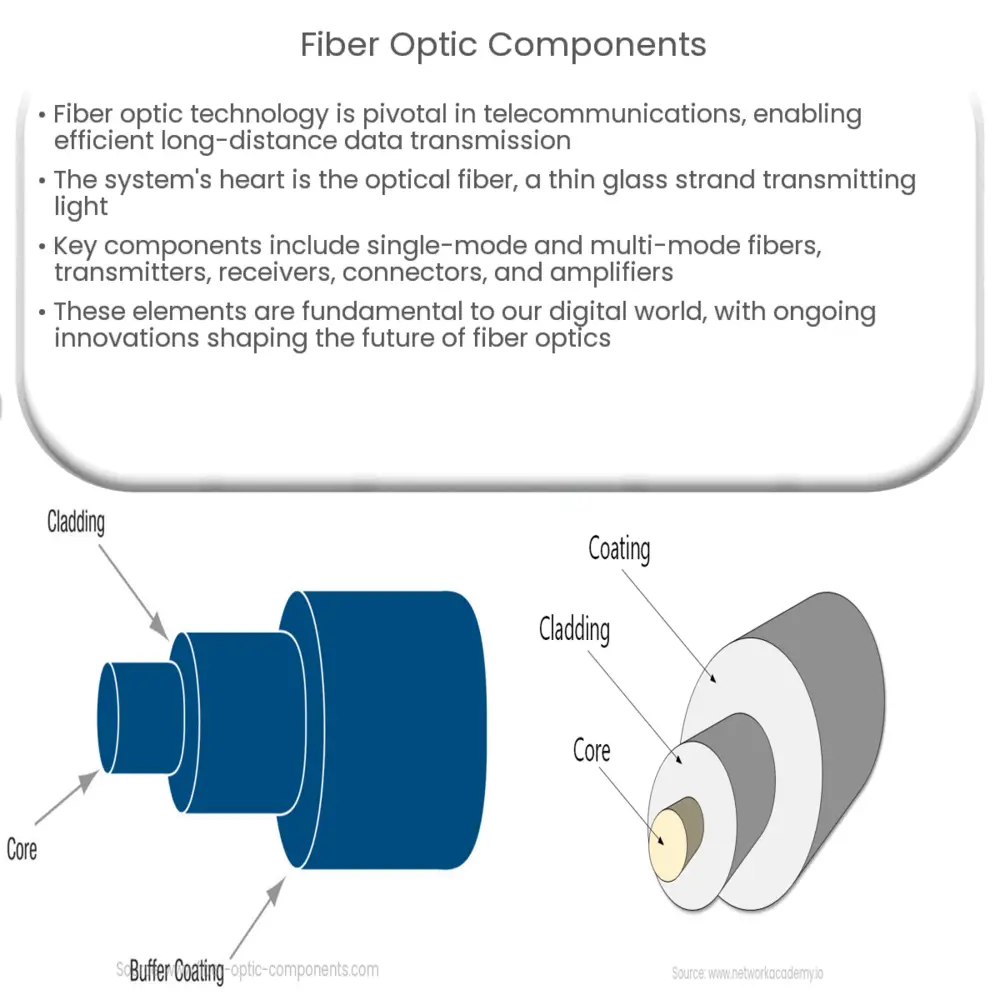Explore the fundamental components of fiber optic technology, including optical fibers, transmitters, receivers, connectors, splices, amplifiers, and more.

Fiber Optic Components: The Key Elements of Optical Communication
Fiber optic technology is at the forefront of the telecommunications industry, providing rapid, efficient data transmission over vast distances. At the heart of this technology lie several core components that enable the smooth functioning of a fiber optic system. These crucial elements include the optical fiber itself, connectors, splices, transmitters, receivers, and amplifiers, among others.
Optical Fiber
At the core of a fiber optic system is the optical fiber – a flexible, transparent strand of glass, thinner than a human hair. This is used as a conduit to transmit light between two ends of the fiber. Optical fiber is formed by drawing glass or plastic to a diameter slightly thicker than that of a human hair. A typical optical fiber consists of a core surrounded by a cladding layer, both of which are made from dielectric materials. The core, where light is transmitted, has a higher refractive index than the cladding, ensuring total internal reflection of light within the core.
- Single-Mode Fiber: This type of fiber carries a single ray of light, typically operating at a wavelength of 1310 or 1550 nanometers. It offers a higher transmission rate and up to 50 times more distance than multi-mode fiber.
- Multi-Mode Fiber: These fibers are designed to carry multiple light rays or modes, each at a slightly different reflection angle within the optical fiber core. They typically operate at a wavelength of 850 or 1300 nanometers.
Transmitters and Receivers
The fiber optic transmitters are the devices that convert an electrical signal into a light signal, which can be then transmitted through the optical fiber. These are usually made up of a LED (Light Emitting Diode) or an ILD (Injection Laser Diode). On the other end of the system, we have fiber optic receivers that transform the light signal back into an electrical signal.
Connectors and Splices
Connectors are crucial components that facilitate the coupling of light from one optical fiber to another. These are typically used when the system requires flexibility at the fiber ends. On the other hand, splices provide a permanent joint between two fibers. There are two primary types of fiber optic splices – fusion splices and mechanical splices.
Fusion Splices and Mechanical Splices
Fusion splicing is the process of fusing or welding two fibers together usually by an electric arc. This is the most widely used method of splicing as it provides for the lowest loss and least reflectance, as well as providing the strongest and most reliable joint between two fibers.
Mechanical splicing, on the other hand, holds the two fiber ends in a precisely aligned position, thus enabling light to pass from one fiber into the other. While it doesn’t provide as reliable a connection as fusion splicing, it is quicker and easier to accomplish.
Amplifiers
In any long-distance communication system, the signal suffers attenuation and requires amplification. In fiber optic systems, optical amplifiers are used to boost the signal. The most common type is the Erbium Doped Fiber Amplifier (EDFA), which can amplify a wide range of wavelengths simultaneously (C-band or L-band).
Fiber Optic Couplers and Splitters
Fiber optic couplers and splitters play a crucial role in many fiber optic networks. A coupler either combines signals from multiple fibers into one or splits the signal from one fiber into multiple fibers. They are needed in systems where a single source is to be distributed among many users or where multiple sources need to be combined onto a single fiber.
Conclusion
In conclusion, fiber optic components serve as the building blocks of the digital world, facilitating the swift, efficient transmission of data that we rely on daily. From the optical fiber itself to transmitters, receivers, connectors, splices, amplifiers, couplers, and splitters – each component plays a unique and indispensable role in the function of the fiber optic system. With the continuous advancements in fiber optic technology, it’s exciting to anticipate what the future holds for this vital field.

